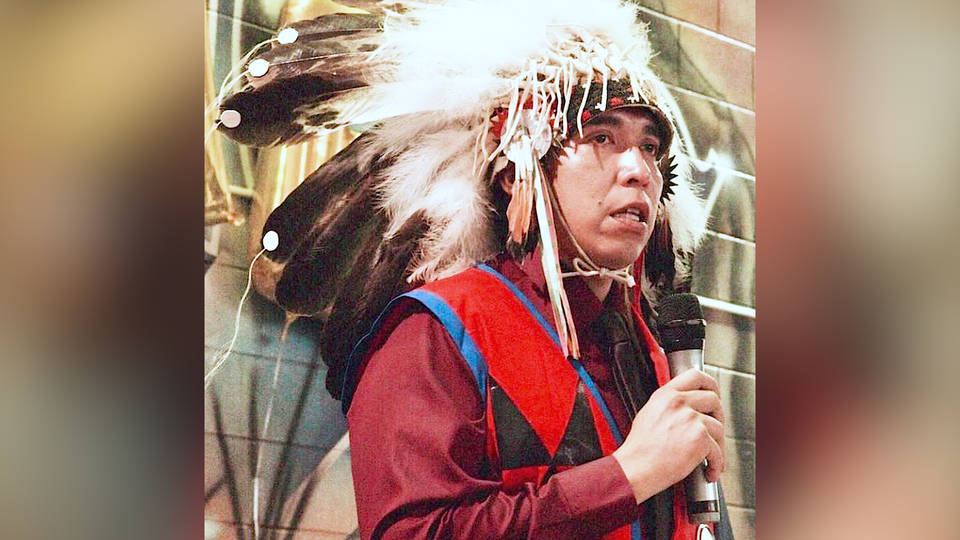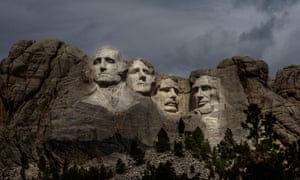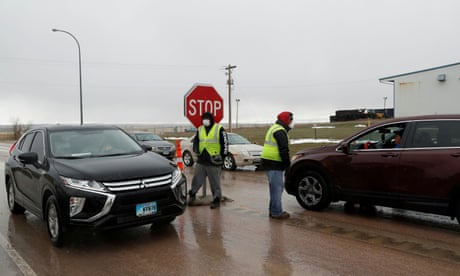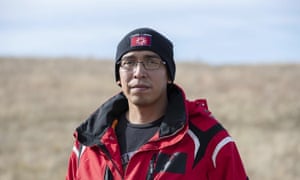JUL 01, 2020

In South Dakota, the president of the Oglala Sioux Tribe has ordered President Trump to cancel a planned visit to Mount Rushmore on July 3 for his Independence Day celebration. Julian Bear Runner told The Guardian, “The lands on which that mountain is carved and the lands he’s about to visit belong to the Great Sioux nation under a treaty signed in 1851 and the Fort Laramie Treaty of 1868 and I have to tell him he doesn’t have permission from its original sovereign owners to enter the territory at this time.”
Donald Trump should stay away from Mount Rushmore, Sioux leader says
The president’s planned visit to the monument on ‘stolen’ Native land risks spreading coronavirus, tribal president warns
Edward Helmore
Wed 1 Jul 2020 09.00 BSTLast modified on Wed 1 Jul 2020 20.25 BST

Mount Rushmore in South Dakota. ‘Trump coming here is a safety concern,’ said the Oglala Sioux president, Julian Bear Runner. Photograph: Kerem Yucel/AFP via Getty Images

Donald Trump should not carry out his planned 3 July visit to Mount Rushmore in South Dakota because it represents a safety risk in the middle of the coronavirus pandemic and is an insult to Native Americans on whose stolen land it was built, the president of the Oglala Sioux tribal council has said.
Several Native American groups are planning protests for Trump’s controversial trip to the 79-year-old stone monument carved into the Black Hills that is set to include the first fireworks display at the site since 2009 and an air force flypast.
“Trump coming here is a safety concern not just for my people inside and outside the reservation, but for people in the Great Plains. We have such limited resources in Black Hills, and we’re already seeing infections rising,” the Oglala Sioux president, Julian Bear Runner, in an interview with the Guardian.

South Dakota governor threatens to sue over Sioux's coronavirus roadblocks
Read more
“It’s going to cause an uproar if he comes here. People are going to want to exercise their first amendment rights to protest and we do not want to see anyone get hurt or the lands be destroyed,” Bear Runner said.
Trump’s visit to the huge site that commemorates four US presidents was a violation of the historic treaties that the US government had signed with Native Americans that were meant to govern the sacred Black Hills, the Oglala tribal president said, adding that Trump should have asked permission for the trip from the seven Sioux tribal governments.
“The lands on which that mountain is carved and the lands he’s about to visit belong to the Great Sioux nation under a treaty signed in 1851 and the Fort Laramie Treaty of 1868 and I have to tell him he doesn’t have permission from its original sovereign owners to enter the territory at this time,” Bear Runner said.
The 1868 treaty acknowledged Sioux sovereignty over the Black Hills in perpetuity but after gold was discovered in the area the federal government forced the Sioux to relinquish this part of their reservation. In 1980, the US supreme court ruled that tribal lands covered by the treaty had been taken from the Sioux illegally.
Julian Bear Runner, president of the Oglala Sioux tribal council.

Donald Trump should not carry out his planned 3 July visit to Mount Rushmore in South Dakota because it represents a safety risk in the middle of the coronavirus pandemic and is an insult to Native Americans on whose stolen land it was built, the president of the Oglala Sioux tribal council has said.
Several Native American groups are planning protests for Trump’s controversial trip to the 79-year-old stone monument carved into the Black Hills that is set to include the first fireworks display at the site since 2009 and an air force flypast.
“Trump coming here is a safety concern not just for my people inside and outside the reservation, but for people in the Great Plains. We have such limited resources in Black Hills, and we’re already seeing infections rising,” the Oglala Sioux president, Julian Bear Runner, in an interview with the Guardian.

South Dakota governor threatens to sue over Sioux's coronavirus roadblocks
Read more
“It’s going to cause an uproar if he comes here. People are going to want to exercise their first amendment rights to protest and we do not want to see anyone get hurt or the lands be destroyed,” Bear Runner said.
Trump’s visit to the huge site that commemorates four US presidents was a violation of the historic treaties that the US government had signed with Native Americans that were meant to govern the sacred Black Hills, the Oglala tribal president said, adding that Trump should have asked permission for the trip from the seven Sioux tribal governments.
“The lands on which that mountain is carved and the lands he’s about to visit belong to the Great Sioux nation under a treaty signed in 1851 and the Fort Laramie Treaty of 1868 and I have to tell him he doesn’t have permission from its original sovereign owners to enter the territory at this time,” Bear Runner said.
The 1868 treaty acknowledged Sioux sovereignty over the Black Hills in perpetuity but after gold was discovered in the area the federal government forced the Sioux to relinquish this part of their reservation. In 1980, the US supreme court ruled that tribal lands covered by the treaty had been taken from the Sioux illegally.

Julian Bear Runner, president of the Oglala Sioux tribal council.
Photograph: Ryan Hermans/AP
Bear Runner added that Trump’s visit could only be approved if the US president sat down with the leaders of the seven tribal councils in a government-to-government consultation.
“As leader of the United States he has obligation to … honor the treaties that are the supreme law of the land,” the 34-year-old president said.
Trump’s visit comes after months of escalating tensions between Native Americans and South Dakota state and federal authorities over jurisdictional power to isolate reservation lands from the spread of Covid-19 that has devastated many Native communities elsewhere.
In early May, leaders of the Oglala and Cheyenne River Sioux refused a request from South Dakota’s Republican governor, Kristi Noem, to remove checkpoints leading to their reservation that they say have helped protect the tribe from all but a handful of coronavirus cases.
Last week, the Cheyenne Sioux accused Trump administration officials of a sustained and unlawful campaign of threats against the tribe aimed at taking control of tribal land policing after the Cheyenne and Oglala Sioux rejected Noem’s demands.
Trump’s planned visit also comes amid a reckoning over racism and a reconsideration of provocative representations of colonial power across the US.
In New Mexico, home to more than a dozen Pueblo Indian reservations as well as part of the Navajo Nation, a movement is under way to the remove monuments to the Spanish conquistadors Juan de Oñate and Diego de Vargas.
Native American activists have argued for years that the memorial to US presidents carved into Mount Rushmore is equally offensive as monuments to Confederate leaders or Spanish conquistadors.
The monument was, they argue, carved into a mountain with its own spiritual meaning, sits on stolen land, was designed and executed by a sculptor, Gutzon Borglum, who had ties to white supremacists, and represents presidents each of whom had dirty hands in terms of slavery and racial oppression.
“The rocks already had spiritual meaning before westerners came to squat our territory,” Bear Runner said. “The land is rightfully ours, and we didn’t give the Black Hills over. It would be wrong for me as a tribal leader to remain diplomatic. We consider the carvings a symbol of trying to wipe us away and to say they had conquered us.”
For years there have been calls by activists to remove the four presidents – George Washington, Thomas Jefferson, Abraham Lincoln and Theodore Roosevelt – from the mountain. Each either owned slaves, made racist remarks or initiated actions that contributed harm to Native peoples.
Of the four, Lincoln gives the greatest offense to Native Americans for ordering the largest mass execution in American history when 38 Sioux were hanged in Minnesota during the Dakota war of 1862.
“They don’t tell the true story and it’s wrong. We hear only the highlighted story of the good things these men have done for this country but they don’t tell that this land belongs to Native Americans, that the Black Hills belong to the Sioux nations, or the hanging of these Dakota men,” Bear Runner said.
The social and cultural desecration the monument represents, has led many Native activists to call for the removal of the monument. But Governor Noem tweeted last week: “Not on my watch.”
Bear Runner added that Trump’s visit could only be approved if the US president sat down with the leaders of the seven tribal councils in a government-to-government consultation.
“As leader of the United States he has obligation to … honor the treaties that are the supreme law of the land,” the 34-year-old president said.
Trump’s visit comes after months of escalating tensions between Native Americans and South Dakota state and federal authorities over jurisdictional power to isolate reservation lands from the spread of Covid-19 that has devastated many Native communities elsewhere.
In early May, leaders of the Oglala and Cheyenne River Sioux refused a request from South Dakota’s Republican governor, Kristi Noem, to remove checkpoints leading to their reservation that they say have helped protect the tribe from all but a handful of coronavirus cases.
Last week, the Cheyenne Sioux accused Trump administration officials of a sustained and unlawful campaign of threats against the tribe aimed at taking control of tribal land policing after the Cheyenne and Oglala Sioux rejected Noem’s demands.
Trump’s planned visit also comes amid a reckoning over racism and a reconsideration of provocative representations of colonial power across the US.
In New Mexico, home to more than a dozen Pueblo Indian reservations as well as part of the Navajo Nation, a movement is under way to the remove monuments to the Spanish conquistadors Juan de Oñate and Diego de Vargas.
Native American activists have argued for years that the memorial to US presidents carved into Mount Rushmore is equally offensive as monuments to Confederate leaders or Spanish conquistadors.
The monument was, they argue, carved into a mountain with its own spiritual meaning, sits on stolen land, was designed and executed by a sculptor, Gutzon Borglum, who had ties to white supremacists, and represents presidents each of whom had dirty hands in terms of slavery and racial oppression.
“The rocks already had spiritual meaning before westerners came to squat our territory,” Bear Runner said. “The land is rightfully ours, and we didn’t give the Black Hills over. It would be wrong for me as a tribal leader to remain diplomatic. We consider the carvings a symbol of trying to wipe us away and to say they had conquered us.”
For years there have been calls by activists to remove the four presidents – George Washington, Thomas Jefferson, Abraham Lincoln and Theodore Roosevelt – from the mountain. Each either owned slaves, made racist remarks or initiated actions that contributed harm to Native peoples.
Of the four, Lincoln gives the greatest offense to Native Americans for ordering the largest mass execution in American history when 38 Sioux were hanged in Minnesota during the Dakota war of 1862.
“They don’t tell the true story and it’s wrong. We hear only the highlighted story of the good things these men have done for this country but they don’t tell that this land belongs to Native Americans, that the Black Hills belong to the Sioux nations, or the hanging of these Dakota men,” Bear Runner said.
The social and cultural desecration the monument represents, has led many Native activists to call for the removal of the monument. But Governor Noem tweeted last week: “Not on my watch.”
No comments:
Post a Comment